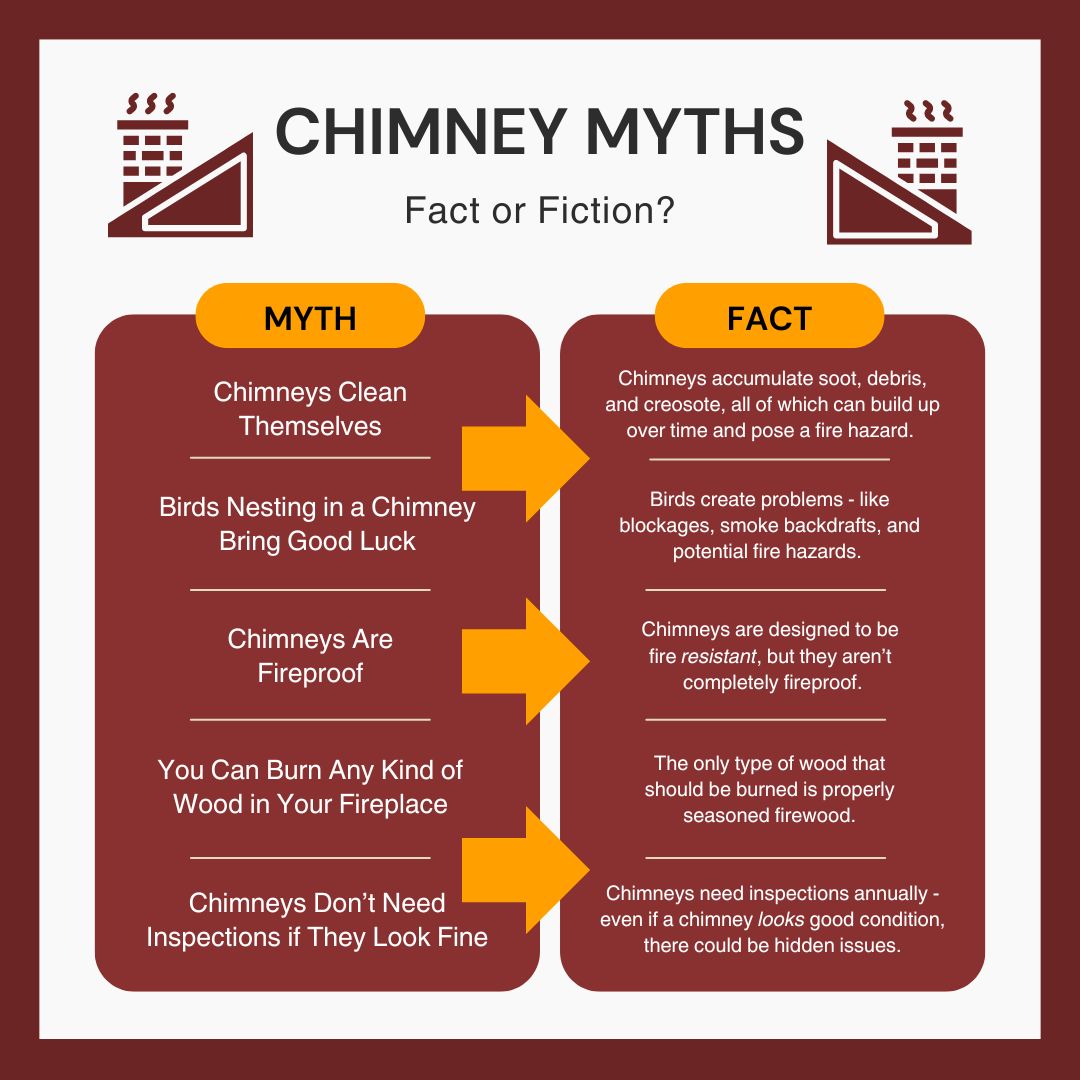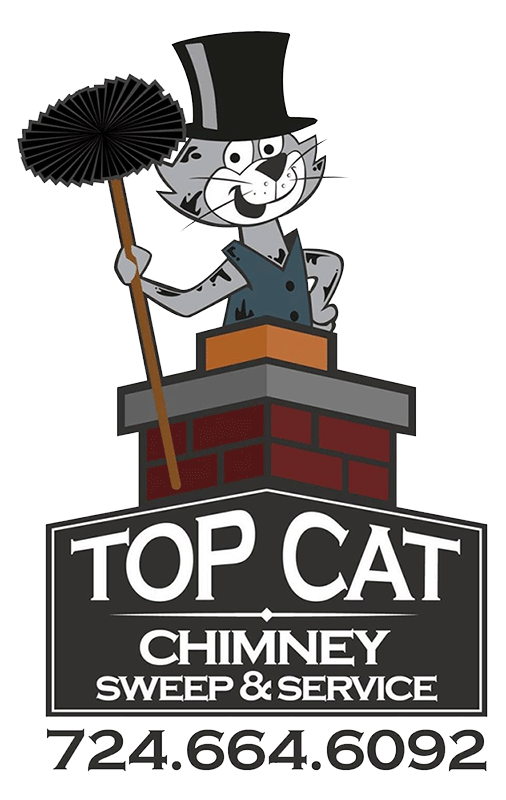Chimneys have been around a while, bringing the benefits of a crackling fire into homes without the accompanying smoke and gases. In that time, a number of myths have arisen related to fireplaces and chimneys. Some of these are just fun to explore – and understanding others helps you take your chimney maintenance and care in the right direction.
Need to book an appointment? We’re here for you – call or schedule online now.

Myth or Fact: Chimneys Clean Themselves
After all, when you’re cleaning off your s’more stick, you hold it in the fire to burn everything off. So doesn’t the heat in the chimney help keep it clear?
Truth status: Myth
Chimneys accumulate soot and creosote – a tarry, combustible byproduct of combustion – which can build up over time and pose a fire hazard. Debris and nesting materials can also build up in chimneys, becoming a potential fire hazard or hindering good, healthy ventilation. Regular professional chimney sweeping removes creosote and other obstructions to ensure proper ventilation and safety.
Myth or Fact: Chimneys Are Fireproof
They’re exposed to high heat and potentially drifting sparks all the time, plus they’re made of brick and metal – so chimneys are definitely fireproof, right?
Truth Status: Mostly Myth
Chimneys are designed to be fire resistant, but they aren’t completely fireproof and can be damaged to exposure to fire.
This is another reason to have your chimney swept regularly, and if you’ve suffered a chimney fire, have a rigorous professional inspection. Thankfully, chimneys are designed with fire stops and liners to help minimize the risk of fire spreading. But if your chimney has had a fire or is otherwise damaged or deteriorating, its ability to work effectively may be compromised.
Myth or Fact: Fireplaces Add Value to Your Home
Who doesn’t love a fireplace? Undoubtedly, having one is an unqualified asset.
Truth Status: True! …with a caveat.
A well-maintained fireplace can enhance the ambiance and charm of a home and add value both to the homeowner and potential buyers, in the case that the homeowner is looking to sell.
But in some cases, a potential homebuyer may not view it as a valuable feature. For instance, an older fireplace may require costly repairs or upgrades to meet modern safety standards and function efficiently. The value added by a fireplace depends on factors such as its condition, which is why staying on top of repairs, inspections, and maintenance is important.
Myth or Fact: You Can Burn Any Kind of Wood in Your Fireplace
That’s what a fireplace is designed for, isn’t it? And if the occasional paper plate or cardboard box slips in there too, no big deal.
Truth Status: Myth
First, we need to make sure – we’re definitely talking about a wood-burning fireplace, right? Remember that a fireplace should only use the fuel type it’s designed for.
Second, it’s a misconception that any kind of wood can be safely burned in a wood burning fireplace. Burning logs that are damp or green (freshly cut) will lead to lots of smoke and accelerated build up of creosote, and burning wood that’s been treated by staining, painting, or other processes can emit toxic fumes.
The only type of wood that should be burned is properly seasoned firewood – in other words, firewood that’s been dried until the moisture level is appropriate for burning in a fireplace. It’s safer, cleaner, and will give you a better fire too.
As for the napkins and gift wrap, or other tempting tidbits you may want to burn? Don’t do it. Some otherwise innocuous items release toxins when burned, burn too hot and uncontrollably, or can drift easily into the room or up the chimney while ignited. Yikes!
Myth or Fact: Birds Nesting in a Chimney Bring Good Luck
Symbolizing good luck and prosperity, a bird making itself at home in your chimney means good luck is coming your way.
Truth status: Myth
Contrary to folklore, birds in chimneys are more of a problem than a blessing. They create problems like blockages, smoke backdrafts, and potential fire hazards. So, instead of welcoming your avian guests, make sure your chimney cap is securely blocking them from nesting in your chimney. Trust us – they’re safer in a tree anyway!
Myth or Fact: Chimneys Don’t Need Inspections if They Look Fine
Seeing is believing, and if a chimney looks fine, it probably is, right? But if you notice damage, it’s probably time to call in the pros.
Truth Status: Myth
Even if a chimney looks in good condition from where you’re standing, remember that many components are obscured from easy view. Hidden issues, such as creosote build up, deteriorating masonry, or a cracked flue liner, can pose safety risk, and can amplify if left unaddressed.
That’s why the Chimney Safety Institute of America (CSIA) calls for annual chimney inspections by a certified professional.
Myth or Fact: Fireplaces Are Highly Efficient Heating Sources
People have been relying on fireplaces for centuries, so they must be the standard of home heating efficiency.
Truth Status: It depends.
Traditional open fireplaces create ambiance and warmth, but when it comes to modern home heating, they aren’t a very efficient option.
Modern fireplace inserts and stoves are designed to improve heating efficiency, however. They circulate air around the firebox and are geared toward great heat output and minimized heat loss.
If you want to make your open fireplace more efficient, make sure it’s well maintained, the dampers are working, you’re burning good quality seasoned firewood, and surrounding walls are well insulated. To maximize efficiency – or switch fuel types – consider installing a fireplace insert into the opening of your existing fireplace.
Myth or Fact: Top Cat Chimney Is the Go-To Choice for Chimney Services in the Pittsburgh Area
True!
When it comes to chimney care, you need a seasoned professional who knows their stuff. Our team is experienced, knowledgeable, and service oriented – not to mention certified, licensed, and insured for our customers’ protection. You can trust us with all your chimney-related needs: inspections, installations, maintenance, masonry, and more.
If you have concerns about your chimney, questions about efficiency or upgrades, or an idea for a new installation, don’t hesitate to reach out!
